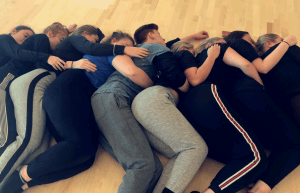When thinking about thinking in movement, I find it bizarre. How do we think in movement when we are not aware of thinking? It just seems to happen, the mind and body become one to produce ‘something which never before was..’ and ‘..something which will never be again’ (Sheets-Johnstone, 2017, 8). I find this aspect of CI interesting, and shows that the body is a remarkable thing.
The first task of the week was hand on the back, and I feel this exercise related to our research lab last week with what senses are heightened when we cannot see. I was aware of all of my senses, but my touch was heightened the most. Apart from the pressure of the hand I could also feel the heat from them too, even after the hand was removed I still had the sensation that the hand was still there. For this exercise I imagined one body moving in the space, not two individuals moving separately, and this really helped myself listen to where I needed to go.
Now we have a variety of tools to work with I find the jams easier and fun. At first it was hard to go in because I did not know how things would go, however they seemed to go pretty well. I enjoyed putting the tools to practice and exploring new ways of moving while keeping in contact. I was lost in the motion of movement, that I forgot I was inside the circle and that other people was watching. I felt confident even when I worked with Abbie, because I had never worked with her in CI until that moment, however I took on board what was said in Thinking in movement that CI is ‘an unrehearsed and spontaneous form of dance’ (Sheets-Johnstone, 2017, 8). With this in my head, I listened and moved with her and just expected the unexpected, and in my opinion I felt we made a good connection.
On two occasions I was part of a group, the first was at quartet and it was unintended and I could have worked with it, but because it was unfamiliar ground I froze and reset with my original partner. I wish I had experimented with the quartet at a slow pace and seen where it had gone. Although when I became part of a trio, I did try and experiment with simple weight exchanging from one another on the floor. However, when we tried to surf and roll, we struggled with the position we were in, so we returned back to a duet.
Besides throwing myself into CI this week, I did struggle on a few occasions when trying to move over table top. I need to practice moving and rotating myself on someone’s back because I have difficulty getting over, and I think that is because I am not in the right position. The second exercise is going backwards over table top. I know I put the weight into my head, and I need to transfer that weight from my head into my hands.
I really enjoyed this week’s CI, I feel I am pushing myself to experiment more with the tools that we have been given, and feel comfortable to experiment these tools with anyone in the class. I cannot wait for what the next few weeks bring.
Sheets-Johnstone, M. (2017) Thinking in Movement. Contact Quarterly, vol 42: 1, pp. 7-12.
